As a progressive livestock farmer, you know already know how important it is to manage your pasture.
It can help you increase production by up to 20%. It can also help you save a lot of money in feed costs, as much as 385 dollars per hectare.
But how do you manage your pasture effectively? You do it by implementing a grazing system that meets your needs.
I wrote this comprehensive guide to help you learn everything about grazing systems. But more importantly, I wrote it to help you choose the best pasture and grazing system for your needs.
This guide has three sections:
In section one, I’ll tell you about the origins of continuous grazing systems and why it might not be the best system for you.
In section two, I’ll tell you everything you need about rotational grazing systems. I'll even show you how to implement ten different rotational grazing system variations.
In section three, I’ll help you consider different fencing options and help you choose the best grazing system for your needs.
By the end of this guide, you’ll have definitive answers to many questions you might have.
In Section 1, I’ll tell you about continuous grazing systems
- How continuous grazing systems originated and evolved over the last 10,000 years?
- What are the biggest disadvantages of continuous grazing systems?
- And why continuous set-stocking systems are better?
In Section 2, I’ll talk about rotational grazing systems, I’ll tell you
- Why rotational grazing systems are better?
- What are the ten best rotational grazing systems?
In Section 3, I’ll tell you how to choose the best grazing system for your needs
- How to analyze the pros and cons of each grazing system?
- How to choose a grazing system that meets all your needs?
- And the benefits of automating your grazing management?
- t's begin by going back about 10,000 years in time.
Section 1: Continuous grazing systems
10,000 Years Ago…
Since humans first started domesticating animals, we have been grazing animals such as cows, goats and sheep.
Some historians argue that grazing animal herds came before agriculture.
Grazing is one of humanity’s oldest food production systems. It has helped us survive and thrive on this planet.
Even today, grazing is still a key part of our food production system.
However, industrialisation, globalisation, longer average human lifespans, increasing incomes and changing dietary preferences have resulted in two significant shifts.
- One, to meet global demand, we now need to produce significantly more meat, milk and animal products.
- And two, increasing customer awareness and a changing climate mandates more sustainable production.
Several pioneering farmers and scientists have shown us how we can evolve our grazing systems to produce more sustainably.
And a big part of this involves shifting from continuous grazing to some pattern of rotational grazing.
But before we go into that, let's understand continuous grazing systems and its limitations.
The origins of continuous grazing
Did you know that a bunch of wild herbivores settled down in large herds, occupied several grasslands and savannahs, even before humans settled down near rivers and watersheds across the world?

As you can imagine, an animal in such a herd would have grazed the open grasslands continuously – urinating, defecating and fertilising the grasslands several times.
At least until it would have until it got hunted down by a lion or leopard.
This system of open grazing sustained several life forms across thousands of years.
And then we adapted this pattern to provide for our needs. We began managing smaller herds and protected them from predators.
Eventually, we even began demarcating private properties, fenced them off and grew livestock on them.
And until very recently, we only practised some form of continuous grazing system.
But why is continuous grazing bad?
Even today, most livestock farmers practice continuous grazing systems.
A majority of them are small herders across Asia and Africa, grazing common lands that are accessible and convenient to them.
If animals have unrestricted and uninterrupted access to a piece of land, we call this continuous grazing.
It doesn’t matter whether a piece of land is continuously grazed throughout the entire year, grazing season or only for a few months. What matters is that animals graze the same piece of land repeatedly, every day.
This system of grazing may appear to be simple, productive, and inexpensive. However, it has several massive disadvantages. Let’s see what they are.
Disadvantage #1 in continuous grazing, you cannot ensure that the entire herd gets enough nutrition. Either because due to insufficient quantity or low nutritional value. Sometimes even both. Why does this happen?
That brings us to disadvantage #2. Over time continuous grazing results in degraded pastures with poor nutrition value. As animals selectively graze the more palatable plants, over time, this favours the not so palatable plants, that don't get eaten. So they grow taller, set more seed and populate the pasture more densely.
Which brings us to disadvantage #3. Repeated rounds of selective grazing create bald patches with no vegetation. This, in turn, results in topsoil being washed away during rains. Without vegetation recycling nutrients in the soil, the nutrients in the soil can get leached away, resulting in lower nutrition.
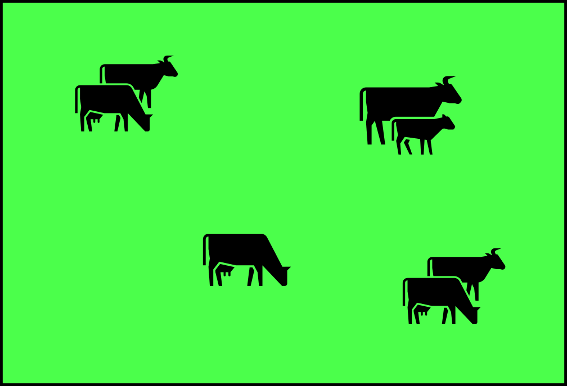
In a nutshell, continuous grazing doesn’t meet the nutritional needs of your herd and also encourages the growth of unwanted plants and depletes the overall nutrition value of your pasture.
So it costs you several times more in lifetime value.
Continuous set stocking systems are better than continuous grazing.
In a continuous set stocking system, you cap the number of livestock units on your farm and ensure that it does not vary on a year to year basis. The key is to balance your stocking rate according to how much pasture your land produces. For better results, farmers stock a lower number of animals.
The main benefits of continuous set stocking grazing are:
- it is simple to implement
- it requires minimal labour
- it doesn’t need additional investments for fencing or measuring pastures
- it can deliver decent production if and only if the pasture condition is maintained well
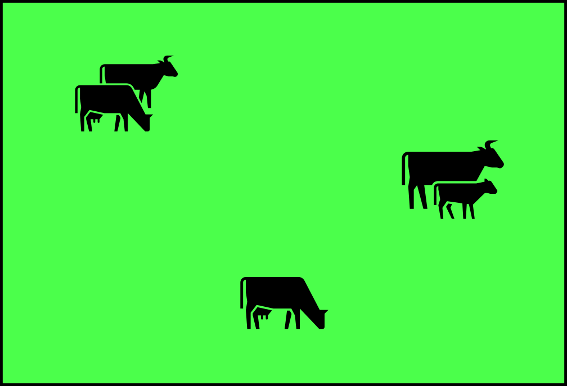
However, in this system, due to seasonal variations and weather conditions, pasture utilisation may be above or below the optimal level at any given time.
In this system, there is a constant risk of overgrazing and degrading the pasture.
Section 2: Different types of rotational grazing systems
Why are rotational grazing systems better?
Now that we have looked at continuous grazing systems and its limitations in considerable detail let's turn our attention towards rotational grazing systems.
I’ll give you six solid reasons to tell you why rotational grazing systems are better:
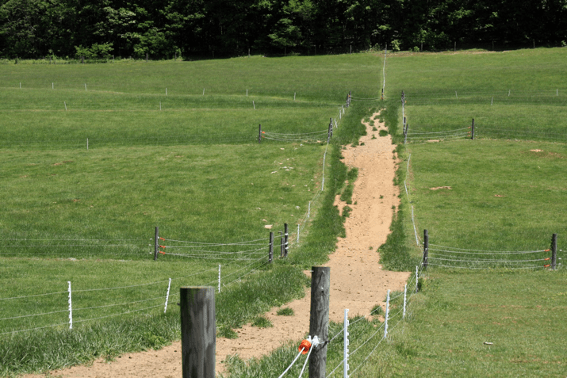
#1 Better Yield:
Rotational grazing allows farmers to maintain target pasture residual height. More importantly, it will give the forage enough rest time to regrow to a suitable grazing height. And finally, it allows the farmers to adjust the number of animals grazing a particular paddock, according to the forage's growth rate.
This is why, compared to continuous grazing systems, improved rotational grazing systems have significantly higher dry matter yields per hectare.
#2 Optimal Nutrition Intakes:
Healthy animals need to eat between 2% to 5% of their body weight in dry matter, every day. For example, a cow that weighs about a thousand pounds will need 20 to 40 pounds of dry matter, every day.
So, to meet your herd’s nutritional needs, you need pastures with at least 1,500 to 2,000 Kg of DM per hectare. In a continuous grazing system, it is impossible to achieve this level of herbage, through the year. It is also impossible to estimate how much DM your animals have consumed on a day-to-day basis.
On the other hand, in rotational grazing systems, you can plan to achieve herbage levels on each paddock and also estimate how much DM your animals have grazed on a daily basis.
#3 Better Quality Pastures:
Rotational grazing systems can better maintain pastures. Why? Because in rotational systems, animals only have access to a limited grazing area, at any given time.
This ensures that the animals graze the entire area uniformly, without giving preference to the more palatable plants. At the same time, it also prevents your animals from gravitating towards their favourite grazing spots near water or under shade.
As a result, your pastures will regrow more uniformly, and unlike continuously grazed pastures they will not degrade quickly.
#4 Faster Regrowth:
With a rotational grazing system, you can set a minimum pasture residual height. This ensures two things:
- plants have enough leaves after grazing
- plants have healthy root systems with enough carbohydrate reserves
Both of this helps the plant to regrow faster. This is why rotationally grazed paddocks regrow more quickly.
For example, look at the below picture. Both pots are planted with the same species of orchard grass under the same conditions.

In the above picture, to simulate continuous grazing conditions, the pot on the left is clipped down to 1-inch, every week, for a month. To simulate rotational grazing conditions, the pot on the right is clipped to 3.5 inches twice a month.
In the pot to your right, you can visibly see the vigorous regrowth, several times more than the regrowth on the pot to your left. This demonstrates why rotational grazing can help your pasture regrow faster.
#5 Better Utilization:
Continuously grazed pastures also contain a lot of forage that never gets eaten. This eventually withers and decays.
It is estimated that continuous grazing systems use only as little as 30 to 50% of the total available forage. The rest of the fodder is either trampled, soiled, or withers and dies. Rotational grazing alone can help you adjust grazing periods to utilise your pastures better, as high as up to 75%.
#6 Better Nutrient Recycling:
You also might have noticed that grass grows better in patches near water bodies or shade trees. Why?
As discussed earlier, animals tend to gravitate towards a few favourite spots. These are usually near water bodies or trees. This is why tests show that soil within 50 feet of shade or a water source typically has three to five times more nutrient levels compared to the average nutrient level for the pasture.
The more that cows urinate and defecate in these spots, the more the microbial activity and the higher the soil fertility.
Rotational grazing systems can help you avoid such an uneven concentration of nutrients and recycles it more evenly across the entire paddock.
The smaller sized paddocks also make it easier to amend deficit nutrients and maintain better soil health. This is why rotationally grazed paddocks can better retain soil nutrients.
The Different Systems of Rotational Grazing
You can implement a simple rotational grazing system by subdividing your pasture into many smaller paddocks that are roughly about the same size. You start grazing these paddocks in a planned sequence.
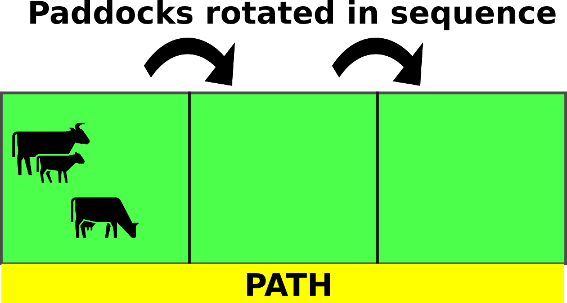
Once all the paddocks have been grazed, the grazing sequence restarts again with the first pasture that was rested the longest. If done correctly, rotational grazing has many benefits, including increased forage production, animal performance, and overall profitability.
Now that we understand how a simple rotational grazing system works and its many advantages let's look at all the different rotational grazing system options.
This will help us select the one that works best for you.
Option 1: Intensive rotational grazing
This system has at least 7 to 8 different paddocks, divided within the pasture. And livestock animals are moved from paddock to paddock based on two factors:
- Forage growth – the amount of dry matter available per hectare
- Utilisation – how much of the total dry matter is consumed
The actual number of paddocks and frequency of grazing rotation will depend upon many factors, such as type of animal, the breed, its nutritional needs, and the production goals of the farm.

However, in general, it is recommended that the animals revisit a paddock after at least seven days.
Intensive rotational grazing can give you higher dry matter yields per hectare. It also allows you to have a much higher stocking rate compared to what is possible in continuous or simple rotational grazing systems.
Also, as discussed earlier, in this system, manure is more evenly distributed in paddocks and weeds are better controlled because the animals are forced to eat everything in a paddock.
However, intensive rotational grazing also requires a higher degree of management and skill. This is why sometimes it is called "management-intensive grazing". Fencing materials, water distribution systems and providing shade in each paddock can increase your initial investments.
Option 2: Creep grazing
As a livestock farmer, you know that your young animals have unique nutrition needs. The creep grazing method helps you provide the best start for your young animals.
In this system, you dedicate a small portion of your pasture to grow high nutrition value crops such as alfalfa or pearl millet. And only younger animals get access to these high-value crops through a creep gate.
Creep grazing can be beneficial for dairy farms, with many nursing calves. Because it allows the young animals to get, a higher daily nutrition intake to supplement their mother’s milk.
In turn, this reduces the energy requirements for the cows and allows for milk production.
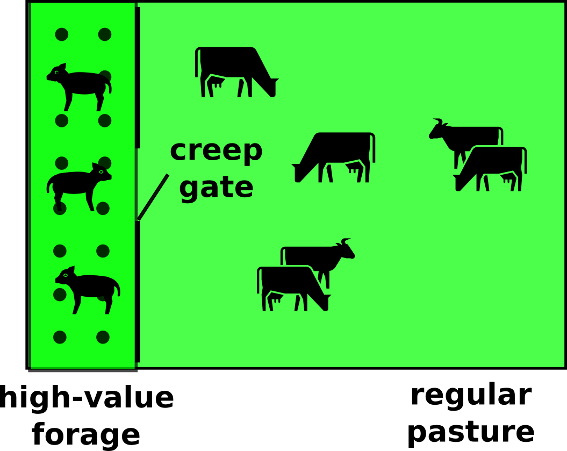
Option 3: Cell grazing
Unlike other rotational grazing systems, the cell grazing system does not allow animals to re-enter a paddock based on a time duration or pasture utilisation.
Instead, in this system animals are let into a paddock, only after plants have regrown sufficiently enough and now hinder the growth of newer plants. In other words, you let the animals graze when your pasture has a healthy root system but hasn't yet set seed.
As you can imagine, there are many practical difficulties in grazing paddocks exactly at this growth stage. To achieve this requires precise planning and intensive management skills.
However, even excellent planning and management can’t always achieve this. Because some pastures may not reach the same stage of growth as others and different plant species may grow at different speeds.
To compensate for this, you could consider implementing one or more of the below strategies:
- Control rest period to suit how your pasture is regrowing
- Adjusting your stocking rate to match the carrying capacity of your land
- Regularly plan, monitor and manage grazing.
- Use maximum animals in a short grazing period
- Use the diversity of plants and animals to improve your pasture.
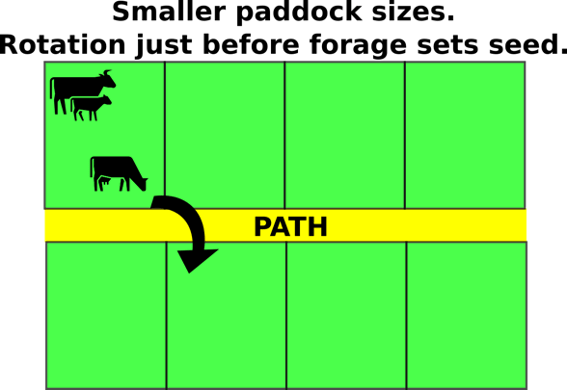
Cell grazing offers several benefits. It improves your pasture, creates a healthy environment, reduces inputs needed and most importantly increases your profit margins.
It improves your pasture because the increased accumulation of organic matter results in better water retention and filtration, which in turn leads to increased growth, biomass and diversity of species. Also, this can help you reduce the impact of prolonged droughts and unreliable rains.
It also reduces your inputs because nutrient levels in the soil are shown to increase with cell grazing and decreases the need for weed control.
Option 4: Strip grazing
In strip grazing, you use a movable, electric fence to allot enough forage for only a short period. And then move the fence so that you shift your herd forward to the next grazing strip, thus providing a new allocation of forage.
Typically no back fencing is used in this method. So to reduce waste due to trampling, grazing should start near water sources. Strip grazing can increase utilisation and decrease animal selectivity.

This method is most useful while grazing stockpiled forages or annual crops. It can also be utilised during certain times of the year while grazing specific forage species like alfalfa in autumn.
Strip grazing can also be used in combination with other rotational grazing systems. For example, dairy cows can be moved twice daily to be milked.
Once grazed, cows are moved to the next field, which is strip grazed while the previous area is rested.
Option 5: Mob grazing
Mob Grazing, also known as ultra-high density grazing involves grazing a large concentration of livestock in a small area for a very short duration.
Anywhere between 200 to 1,000 animals are grazed in a hectare of land and are moved several times per day. Individual paddocks can be grazed as little as 2 to 3 times per year.
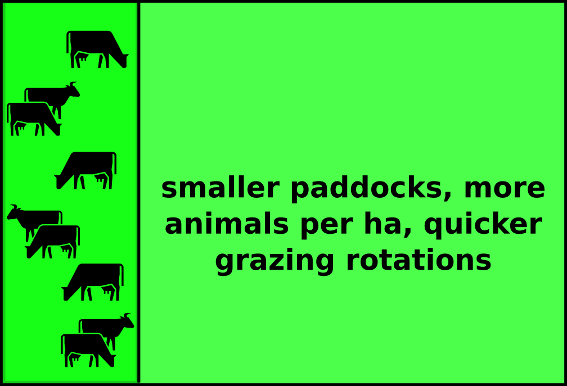
Such long periods of rest allows forages to become mature. This, in turn, allows root systems to establish itself and develop necessary energy stores to regrow quickly. This method forces livestock to graze everything available, so there’s no question of selective grazing at all.
And what is not grazed is trampled back into the ground, helping increase organic matter in the soil. This also enables you to reduce weeds and increase manure distribution.
However, in this method, forage production may be reduced. Research so far has yielded mixed results, and the long term effects on pastures are yet to be studied. This method requires increased labour and is best suited when grazing animals that have lower nutritional needs.
Option 6: Leader-follower grazing
In this method, you would divide your herd into two or more groups based on their nutritional needs. For example, you could group all growing calves in one group and then the adult cows into a second group.
You would then allow the group that has higher nutrition needs, in this case, the calves are let in first. This helps them graze the more nutritious parts of the paddock first. After a couple of hours, the other adult cows can then be let in.
Like creep grazing, this system also helps you prioritise the nutrition needs of different groups within your herd, without any significant addition of labour or expenses.

Option 7: Multi-species grazing
This method may also be extended to two or more different livestock species. For example, you can consider a system where dairy cows are first grazed on paddocks followed by goats.
By doing so, you can significantly increase overall pasture utilisation, because cattle, sheep, and goats prefer to graze different forage species and graze them in different ways.
However, because different species have different needs, such a system might mean increased expenditures in areas such as labour, facilities or equipment.
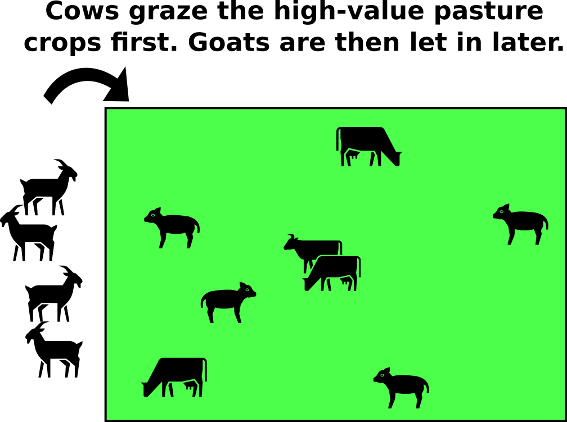
Option 8: Rest rotation grazing
Under the rest rotation system of grazing, you divide your pasture into about three equal parts.
You rest one-third of your pasture completely, without grazing it for a year. And you graze another third of your pasture only after the forage plants set seed and have well-established root systems. Finally, you can graze the remaining one-third of your pasture through the year.
Next year, you repeat the same pattern with one difference. The part that was rested entirely becomes the actively grazed part. The part that was grazed after seeding — now undergoes complete rest. And finally, the part that was actively grazed is now grazed after the forage sets seed. This sequential cycle repeats the next year.
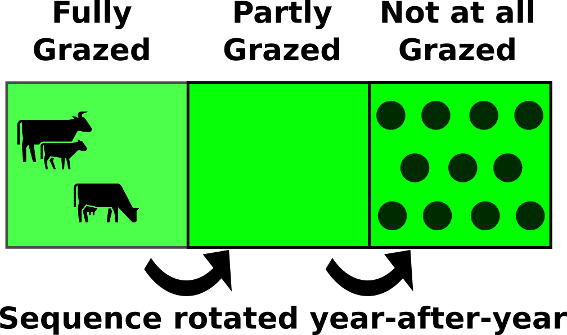
The rest provides an opportunity for vegetation and soils to recover significantly.
However, wild herbivores may graze the rested pastures and negate most of the benefits. Also because now more animals graze a smaller part of your pasture at any given time, this may result in a decrease of overall diet quality.
Also, the benefits of a full year’s rest can quickly be negated when pastures are overgrazed, particularly in arid regions where frequent drought conditions.
Option 9: Techno grazing
In techno grazing, the pasture is divided into a grid of very small grazing cells. Each cell is usually less than 0.1 hectares in area.
Because this system needs a lot of fencing material, farmers almost always adopt temporary fences made of relatively cheaper materials such as fibreglass posts and soft grade wires. These temporary fences are placed across these grazing lanes to form grazing cells.
In most rotational grazing systems, a paddock is around 1 hectare in size. However, in technograzing, each grazing cell is one-hundredth this size. So you effectively have 100 times more animals per acre.
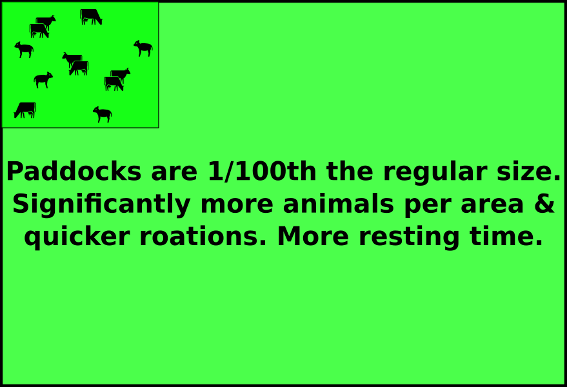
This system restricts animals dry matter intake, especially in the case of larger animals such as dairy or beef cows. But, because the grazing area is divided into such a small zone, this system allows for:
- Greater control over pastures
- Longer pasture recovery and regrowth times
- Intensive cultivation of improved pasture varieties
- More intensive animal management and surveillance
Option 10: Conservation grazing
Unlike the other systems we have seen so far, conservation grazing is not optimised for production.
Instead, in this system, the conservation of local native species and increasing biodiversity are the primary goals. It uses grazing livestock to achieve these goals. And production is just a by-product.
Conservation grazing is generally less intensive than other practices. Still, it needs to be managed to ensure that overgrazing does not occur. This system has proven to be beneficial in restoring and maintaining grassland ecosystems.

That sums up the ten most popular and effective rotational grazing systems. Now let's look at what's the best system for you and your needs.
Section 3: Choosing the best grazing system to meet your needs
Which grazing system is right for you?
As you can see, each of these ten rotational grazing systems has its own set of advantages and disadvantages. Some are more expensive than others, and some need more intensive management.
To choose the right grazing system – you need to be clear about your priorities. In other words, what’s most important for you?
Is higher production your biggest priority? Or does lower effort and management a bigger priority? Your priorities will help you choose the right grazing system for your needs.
To help you quickly map your priorities against the pros and cons of each grazing system, I put together this table.
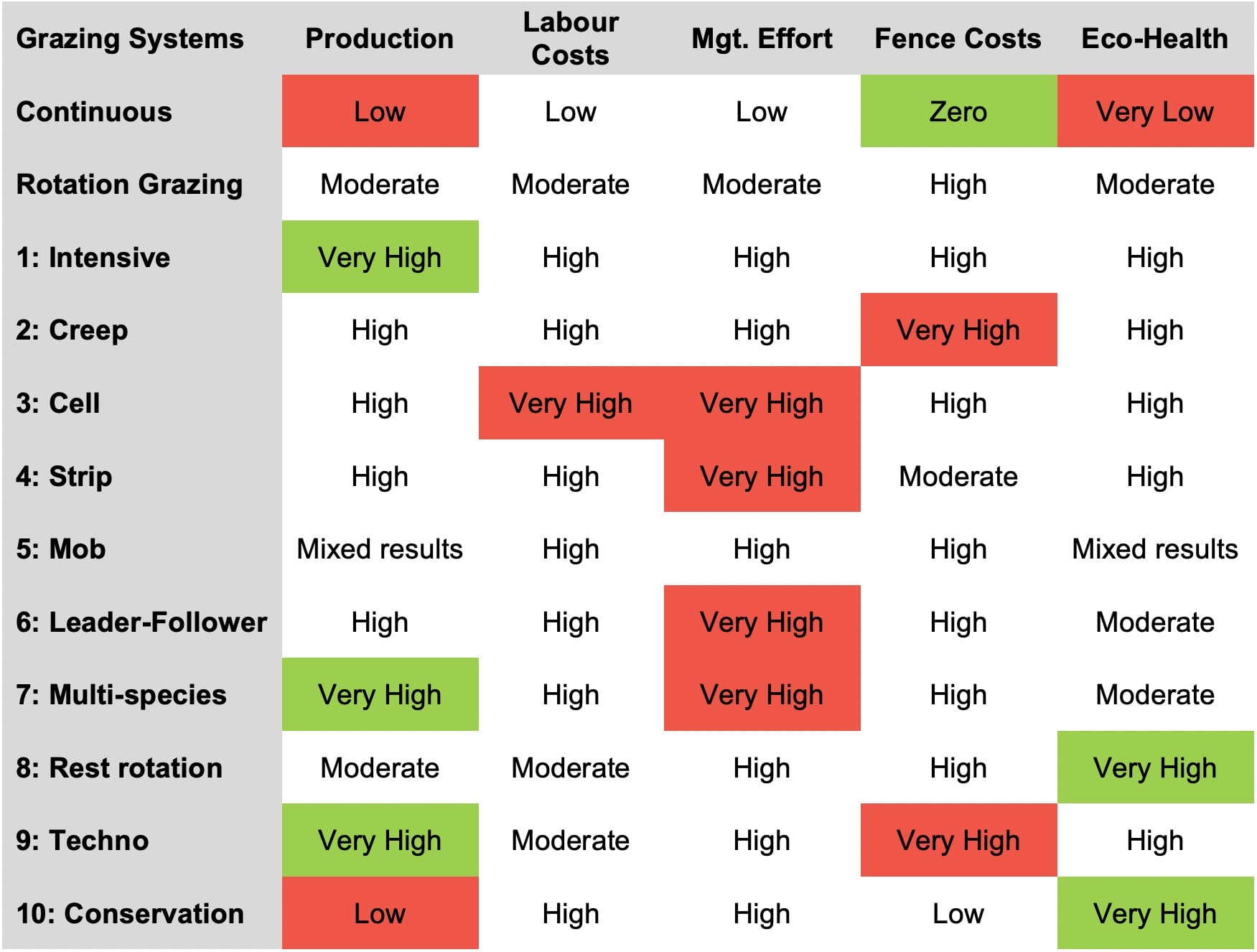
As you can see from the above table, continuous and conservation grazing systems have very low production value. So more likely than not, a progressive farmer like you would reject them.
Three systems, namely – intensive rotation, multi-species and technograzing, have the highest production value. So that's an excellent place to start.
Among these three systems, the multi-species system is not everyone's cup of tea. Because managing multiple species with different needs can take up a lot of your time, at least it will before you get it right.
So if you are optimising your livestock farm for production, you should consider practising either the techno or intensive rotational grazing system.
The primary difference between both these systems lies in management.
In the intensive system, you need to frequently measure herbage data in all your paddocks, at least once a week.
On the other hand, in the technograzing system, you need to shift your animals every few hours from one small cell on your paddock to the next.
Both work well. But among the two, the intensive rotational system has two significant advantages going for it.
First, a big part of this process, collecting herbage data can now be delegated to technology. Today, you have several drone or satellite-based pasture measurement services that can help you measure and analyse your herbage data. This alone can help you save significant labour costs and management effort.
Secondly, by continually monitoring the health and growth of your pasture, you get a better perspective of what's working well and what isn't. This bird's eye view can help you take better decisions to improve your farm's overall productivity.
Choosing the right fencing
If you are looking to implement a highly productive grazing system, you need to find the right fencing for your needs.
In general, you can categorise all your fencing options into permanent or temporary (or movable) fences.
The tried and tested high-tensile wire fence is an excellent permanent option. Typically, large animal farms use 12½ gauge, class III galvanised high-tensile wires. But you can also consider using smaller diameter high-tensile wires such as the 14½-gauge and 16-gauge ones.
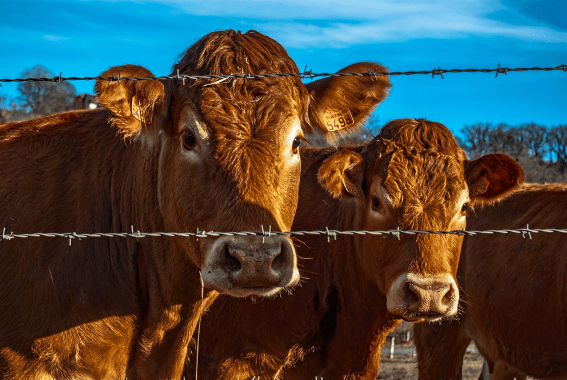
However, you might need to look at sturdier options, at least for your boundary fences, especially if wild animals enter your property.
For your temporary fences, you could consider using more flexible, high-tensile wires. Or you could even opt for a slightly softer grade wire, which will make it easier for you to move them.
This would work very well in rotational grazing systems where you need to enclose a small area and move this enclosure several times a week.
Another excellent alternative for temporary installations is braided wire. They are made of fine-gauge steel wires and polyethylene strands, woven into the form of a wire, ribbon or even tape. These wires work quite well up to a length of 1,000 feet.
Finally, do your research and also ask around for any new fence ideas or materials that are working well.
Further Reading
TO LEARN MORE ABOUT THE IMPORTANCE GRAZING SYSTEMS, READ:
- Introducing the technograzing system by Kiwitech
- Types of Rotational Grazing
- Grazing Strategies to Improve Production
- Voisin Style Rational Grazing
- Consider raising your cows on pasture
- Why You Should Start Rotational Grazing
- The History of Rotational Grazing
- How to Set Up A Rotational Grazing System
- Optimising financial return from grazing
- Use Pasture Measurement to Improve Your Management
- Regular pasture measurements are critical for better pasture utilisation
TO LEARN MORE ABOUT ROTATIONAL GRAZING SYSTEMS, READ:
- Sheep and goat grazing systems
- Rotational Pasture Grazing Systems
- Rotational grazing methods by the University of Kentucky
- Methods of Grazing Management by Penn State University
- The benefits of pasture rangelands (Montana State University)
- Origin, Persistence, and Resolution of the Rotational Grazing Debate
- Grazing strategies by the Meat & Livestock Association and the University of Kentucky
- Origin, Method, Benefits and Criticisms of Cell Grazing
- Research paper on the Techno Grazing System
The benefits of automating your grazing management
A recent study evaluated the production and economic benefits of measuring pastures.
It showed that measuring and managing your pasture frequently can help you increase milk solids produced per hectare by 5% to 6%. And also increase your operating profits by 15% to 19%.

Even with a conservative estimate, taking into account various other factors and costs, the study estimated an increased profit of $385 per hectare per year.
Literally, this means the difference between earning a good living and just getting by.
But life gets in the way. Things break down on the farm. Diseases need to be curtailed. And employees quit or fall sick. Unexpected hiccups like these can keep you from measuring your pasture regularly, even though doing so can help you earn significantly more profits.
So, consider investing in an automatic pasture measurement service such as pasture.io. We use artificial intelligence and high-resolution satellite imagery to measure your pasture growth accurately, up to 3,500 Kg of dry matter per hectare.
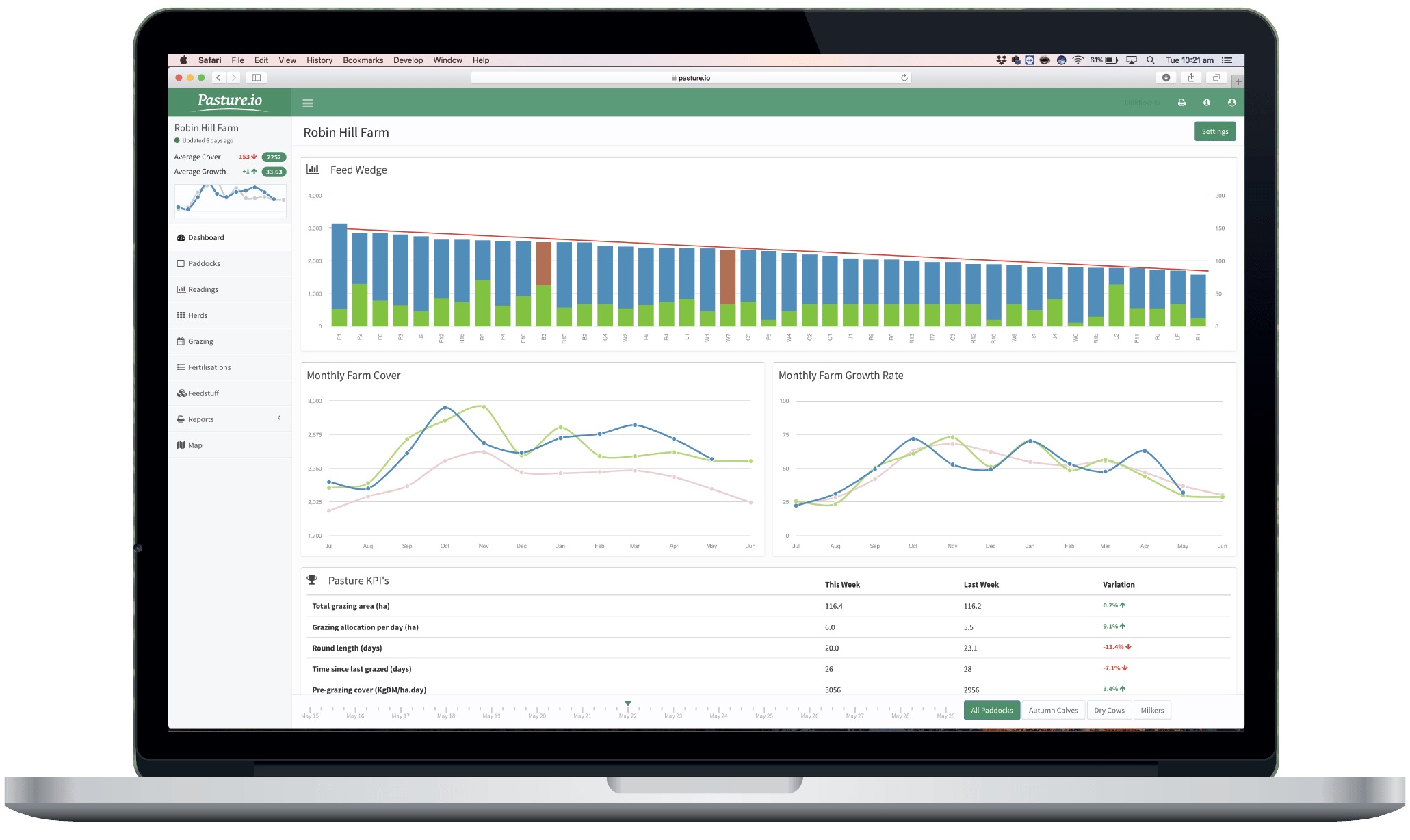
Or manage all your farm records and grazing plans with our forever free plan.
If you are interested, we have a simple pricing structure. You play a flat fee of AUD 1,099 per year, and then pay AUD 8 per hectare per year.
Alternatively, you could try our forever free plan to help you store and analyse all farm records in one place. Check out our service. It might change your life and your pasture for the better.


















